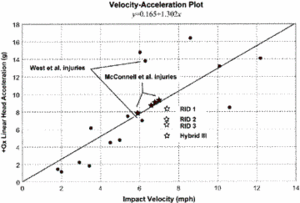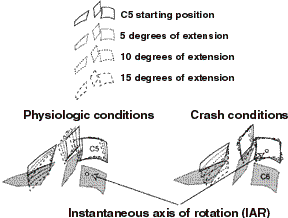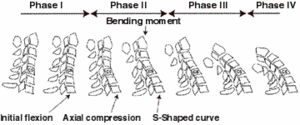Still, a few lingering doubts gnawed at some of us. If it was hyperextension that caused the injury, why did patients, almost without exception, have posterior neck pain? The curious patterns of referred (scleratogenous) pain2,3 provided a measure of satisfying explanation here, but only briefly.
In 1969, inclusion of head restraints was mandated by federal decree. Had hyperextension been the real malefactor we were searching for, we might have expected a significant reduction in the incidence of CAD injury. Instead, only marginal reductions were reported to be directly attributable to head restraints. Complicating the problem of assessing the effectiveness of these restraints was the fact that less than 30% of Americans properly adjust them. Worse still was the finding that an occupant's head would rise above even a properly adjusted restraint as a result of ramping up the seat back. Frequently, the restraint then acted as a fulcrum, intensifying the injury. Often, as noted in full scale crash testing, the head actually rises above the restraint and hammers it down into a lower position. Moreover, the backset -- the distance between the head and the head restraint at the moment of impact -- was found to be critical: more than two inches would render even a perfectly positioned and well anchored restraint nearly useless. And the doleful state of automotive art in this regard was highlighted in a recent Insurance Institute for Highway Safety study which found that less than 10% of the 163 cars tested had "good" head restraints. I'll come back to this problem later.
Meanwhile, another key component in our CAD injury model were muscles. We generally believed that they were strained during this whiplash motion -- hence the term cervical strain/sprain, which also includes a ligamentous component. The model allowed us to explain chronic pain, as well as acute pain, by enlisting the myofascial explanation. Many rheumatologists, though, are now critical of the construct validity of myofascitis. In fact, it is only poorly supported by rather conflicting and poor quality literature.
As a result of these (and many other unmentioned) new insights, I've come to the realization that several parts of this model of CAD injury require fundamental overhaul: 1) global spinal hyperextension is neither necessary as an injury mechanism, nor common; intersegmental hyperextension, however, is one of the likely key factors in injury; 2) muscles appear to be merely an end organ in both acute and chronic neck pain from CAD trauma; and finally 3) pain-conveying and proprioceptive afferents from injured upper cervical spinal structures may be the key players in balance disorders, dizziness, and even many cognitive disorders previously ascribed to mild traumatic brain injuries (MTBI). This afferent activity appears to emanate chiefly from the facet joints, not the muscles. I might add, parenthetically, 4) the prospect for a safer, more effective head restraint and seat back, such as the ones in the new Volvo S80 and a few Saabs, appear to be somewhat bleak based on my analysis of the recent research. Within the confines of limited space, I'll try to justify my thoughts in the following paragraphs.
Hyperextension -- Global vs. Intersegmental
Evidence that the kinematics of the human cervical spine might be somewhat more complex than previously imagined was presented as early as 1992 by Svensson and Lovsund4 using a new anthropometric dummy neck which mounted atop the standard Hybrid III dummy torso. This RID (rear impact dummy) neck proved to be a vast improvement over the existing Hybrid III neck, which has been shown to be too stiff for simulating low speed rear impact crashes (LOSRIC). The new neck's biofidelity was validated against human volunteers in the same crashes. However, it too was a bit too stiff by my calculations. I developed a regression equation (y=0.165 + 1.302x) based on data from another set of volunteer testing (see Figure 1).5 (It is important to make note that the x axis units are in impact speed in mph, not delta V, as is more commonly used in this genre of literature. The change in velocity of the struck vehicle is generally 60-80% of the impact velocity of the striking vehicle.)

Figure 1. A regression line and equation developed from data from human volunteer crash testing (West DH, Gough JP, Harper TK. Low speed collision testing using human subjects. Accid Reconstr J 1993;5(3):22-26) and reproduced with permission from the Whiplash Poster System (r), Spine Research Institute of San Diego. I have plotted several crash sequences of the McConnell et al.7 and West et al. crash tests in which injury occurred (velocity conversion from DV to impact velocity was based on ration calculated from Siegmund. The RID I-III necks differ only in their relative stiffness.
I have spoken with the developers of the RID neck and their theory concerning this continuing biofidelity problem was that the dummy's torso was still a rigid unit. Now there is a new BioRID I dummy with a fully articulated spine (more on that in a forthcoming paper). Be that as it may, the most interesting finding in their 1992 testing was that the neck assumed an s-shaped curve very early after impact. Might a human neck behave similarly? It seemed too early to abandon our standard model of kinematics, considering the limitations of the RID-Hybrid III.
Last year Grauer et al.,6 using dissected human cadaver spines, mounted them on a sled and subjected the specimens to accelerations ranging from 2.5-8.5 g -- well within the range of LOSRIC. Surprisingly, they found that very early on in the crash sequence, the human spine did indeed take on a distinct s-shaped curvature, with the lower segments reaching into the range of hyperextension, while the upper segments were flexing. Subsequently, this same group has published several other papers using the same human specimens, looking at other aspects of the human spine in LOSRIC. Still, a potential drawback in all of these studies is a lack of a torso: all of the cervical spine specimens were mounted directly onto a sled. We know from many other human volunteer crash tests that the torso tends to ramp up the seat back as much as 3.5 inches in even low speed crashes.7,8 During this upward motion, the spine is compressed and this compression must surely influence the behavior (i.e., kinematics) of the spine. Were the results of this study trustworthy? Did the work have sufficient external validity? It still seemed premature to accept this new kinematic model.
The final denouement came with the work of a group of Japanese researchers9 who tested human volunteers on a specially designed sled. Not only did they record the kinematics with high-speed video cameras (as previous researchers had), they also recorded using high-speed cineradiographic equipment. Their results confirmed those of the other researchers: the neck did indeed assume an s-shaped curve within 100 msec or so, and the degree of lower cervical spine extension was beyond that of normal ranges (i.e., these segments were clearly hyperextended). However, in no cases did the global neck motion exceed the normal range of motion. Thus, gross hyperextension did not occur.
Parenthetically, I've been telling my students for many years to avoid the term hyperextension/hyperflexion injury because of the potential medicolegal traps it provided. For example, one has to assume that true hyperextension occurred, and by calling the condition hyperextension, there is an unstated implication that without true hyperextension, injury is unlikely --a dangerously erroneous conclusion in legal matters. Most importantly, injury can and often does occur well within the normal range of motion, as has been witnessed in several crash tests.
When this new model of kinematics is examined more closely, as was allowed with the cine images, it became clear that the instantaneous axis of rotation (IAR) changed position in the lower segments. This places significant compressive force on facet joints and discs. Figure 2, which is adapted from the original paper by Ono et al,9 illustrates this point. It is significant that the compressive forces measured by other researchers were found also in this study. Yang et al.10 reported recently that the stiffness of the intervertebral articulations is reduced to half when a compression force is applied. Thus the cervical vertebrae move more easily when compression is applied and, when the IAR is altered, this bending motion is much more damaging to the intervertebral articulations. The overall motion throughout the four phases of CAD trauma are represented in Figure 3.

Figure 2. At left, the instantaneous axis of rotation (IAR) of the C5 segment under normal physiological bending conditions. At right, under crash loading conditions simulating a 6 km/h (3.7 mph) velocity change, the kinematics of the neck is changed: the IAR of C5 is shifted superiorly into the body of C5, resulting in extension bending that compresses the facet joints of C5 and C6. The effect on the disc is likely adverse as well. (Adapted from Ono et al.9)

Figure 3. The four phases described by Ono et al.9 Note that I also use four phases in describing occupant kinematics during LOSRIC,11 but my phases encompass the entire event from extension to flexion. Ono's group describe four phases only of the extension motion. (Adapted from Ono et al.9)
Facet Joints as a Source of Pain
Before leaving this topic, recall that Nickolai Bogduk and colleagues have, in recent years, demonstrated rather elegantly that about 60% of the chronic pain in late (chronic) whiplash is centered in the facet joints.12 Recall also that Taylor and Twomey13reported facet injuries (among other types) in persons recently subjected to CAD trauma who had subsequently died of unrelated causes. Such cases allowed a unique opportunity to autopsy the usually concealed CAD lesion. Several similar or related papers have also been published. The most important lesson from these studies has been that -- even with the acuity of hindsight -- even the more severe lesions seen at autopsy are not visible on plain film or MRI.
Interestingly enough, the muscles are probably the most injury-resistant tissues in the neck; they refer pain only weakly, and heal with fairly high resiliency. Therefore, they now seem to me to be one of the less important players in both acute and chronic neck pain. However, they are most commonly the target of referred pain from injured spinal tissues, and in volunteer tests in which spinal tissues are stimulated with noxious substances, subjects cannot discern the actual origin of the stimulus -- they feel only the referred muscle pain. This understanding, of course, places chiropractic physicians in a unique position when it comes to management of CAD injuries, because few other practitioners are trained and licensed to manipulate facet joints. This would no doubt explain the greater than 93% success rate of chiropractic therapy reported even in late (chronic) whiplash patients.14
References
- Macnab I. Acceleration injuries of the cervical spine. J Bone Joint Surg 1964;46A(8):1797-1799.
- Bogduk N, Marsland A. The cervical zygapophyseal joints as a source of neck pain. Spine 988;13(6):610-617.
- Dwyer A, Aprill C, Bogduk N. Cervical zygapophyseal joint pain patterns I: a study in normal volunteers. Spine 1990;15(6):453-457.
- Svensson M, Lovsund P. A dummy for rear end collisions: development and validation of a new dummy neck. International IRCOBI Conference on Biomechanics of Impacts. Verona, Italy, September 9-11, 1992;299-309.
- Croft AC. Module 1 of Whiplash: the Masters' Program, Coronado, Spine Research Institute of San Diego, 1996, p. 17.
- Grauer JN, Panjabi MM, Cholewicki J, Nibu K, Dvorak J. Whiplash produces an s-shaped curvature of the neck with hyperextension at lower levels. Spine 1997;22:2489-2494.
- McConnell WE, Howard RP, Poppel JV, et al. Human head and neck kinematic after low velocity rear-end impacts: understanding "whiplash." 39th Stapp Car Crash Conference Proceedings 952724, 1995, p. 215-238.
- McConnell WE, Howard RP, Guzman HM, et al. Analysis of human test subject kinematic responses to low velocity rear end impacts. SAE Tech Paper Series 930889, 1993, p. 21-31.
- Ono K, Kaneoka K, Wittek A, Kajzer J. Cervical injury mechanism based on the analysis of human cervical vertebral motion and head-neck-torso kinematics during low speed rear impacts. 41st Stapp Car Crash Conference Proceedings. SAE paper 973340, 1997, p. 339-356.
- Yang KH, Begman PC, Muser M, Niederer P, Waltz F. On the role of cervical facet joints in rear end impact neck injury mechanisms. SAE SP-1226, Motor Vehicle Safety Design Innovations, SAE Paper 970497, 997, p. 127-129.
- Croft AC. Biomechanics. In: Foreman SM, Croft AC (eds). Whiplash Injuries: the Cervical Acceleration/Deceleration Syndrome, second edition. Baltimore: Williams & Wilkins, 1995, p. 66-71.
- Barnsley L, Lord S, Wallis BJ, Bogduk N. The presence of chronic cervical zygapophysial joint pain after whiplash. Spine 1995;20(1):20-26.
- Taylor JR, Twomey LT. Acute injuries to cervical joints. Spine 1993;18(9):1115-1122.
- Woodward MN, Cook JCH, Gargan MF, Bannister GC. Chiropractic treatment of chronic "whiplash" injuries. Injury 1996;27(9).
Click here for previous articles by Arthur Croft, DC, MS, MPH, FACO.





